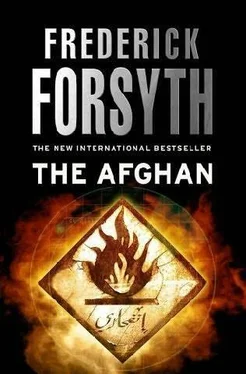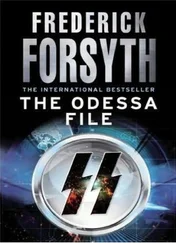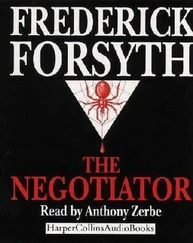The Dona Maria was one of the smaller tankers, a member of that fleet of vessels that service the islands whose facilities neither need nor can accommodate the giants. The big vessels are wont to bring in the Venezuelan crude, which is refined down to its various “fractions” at the onshore refinery, then piped out to the island for loading into the tankers.
Along with two other small tankers, the Dona Maria was at a specially remote section of the tank farm. Her cargo after all was liquefied petroleum gas, and no one wanted to be too close during the loading. It was late afternoon when she was finished and Captain Montalban prepared her for sea. There were still two hours of tropical daylight left when she slipped her mooring lines and eased away from the jetty. A mile offshore, she passed close to a rigid inflatable launch in which four men sat with fishing rods. It was the awaited sign.
The two Indians left their posts, ran below to their lockers and returned with handguns. One went amidships, where the scuppers were closest to the water and the men would board.
The other went to the bridge, and pointed his gun straight at the temple of Captain Montalban.
“Do nothing, please. Captain,” he said with great courtesy. “There is no need to slow down. My friends will board in a few minutes. Do not attempt to broadcast or I will have to shoot you.”
The captain was simply too amazed to fail to obey. As he recovered, he glanced at the radio at one side of the bridge, but the Indian caught his glance and shook his head. At that, all resistance was snuffed out. Minutes later, the four terrorists were aboard and opposition became futile. The last man out of the inflatable slashed it with a carving knife and it sank in the wake when the painter was released. The other three men had already hefted their canvas grips and stepped over the spaghetti mix of pipes, tubes and tank hatches that define a tanker’s foredeck as they made their way aft. They appeared on the bridge seconds later: two Algerians and two Moroccans, the ones Dr. al-Khattab had sent over a month earlier. They spoke only Moorish Arabic, but the two Indians, still courteous, translated. The four South American crewmen were to be summoned to the foredeck, and would wait there. A new course would be calculated and adhered to.
An hour after dark, the four crewmen were coldly murdered and tossed overboard after a length of chain from the forward locker had been secured to each body’s ankle. If Captain Montalban had had any spirit to resist left in him, that was the end of it. The executions were very mechanical; the two Algerians had, back at home, been in the GIA-the Armed Islamic Group-and had slaughtered hundreds of helpless fellahim, outback farmers whose mass murder was simply a way of sending a message to the government in Algiers. Men, women, children, the sick and the old, they had killed them all many times, so four crewmen was just a formality. Through the night the Dona Maria steamed north, but no longer toward her scheduled destination of Puerto Rico. To her port side was the expanse of the Caribbean basin, unbroken all the way to Mexico. To her starboard side, quite close, were the two island chains called the Windward and the Leeward, whose warm seas are often thought of only as vacation destinations but are alive with hundreds of small tramps and tankers that keep the islands supplied and alive for the tourists.
Into this blizzard of coastal freighters and islands, the Dona Maria would disappear, and remain so, until she was logged overdue at Puerto Rico.
***
When the Countess of Richmond reached the doldrums, the sea calmed, and Yusef Ibrahim emerged from his cabin. He was pale, and drained by nausea, but the hate-filled black eyes were the same as he gave his orders. The crew brought out from its storage place in the engine room a twenty-foot inflatable speedboat. When it was fully rigid, it was suspended from the two davits above the stern. It took six men, sweating and grunting, to bring up the one-hundred-horsepower outboard engine from below and fix it to the rear of the speedboat. Then it was winched down to the gentle swell beneath the stern. Fuel tanks were lowered and hooked up. After several false starts, the engine coughed to life. The Indonesian navigator was at the helm, and he took the speedboat away for a fast circle round the Countess. Finally, the other six men descended down a ship’s ladder over the gunwales to join him, leaving only the crippled killer at the helm. It was evident this was a dress rehearsal.
The point of the exercise was to allow the cameraman, Suleiman, to be taken three hundred yards from the freighter, turn and photograph her with his fully digital equipment. When linked through his laptop to the Mini-M sat phone, his images could be transmitted to another website on the other side of the world for recording and broadcast.
Mike Martin knew what he was watching. For terrorism, the Internet and cyberspace have become must-have propaganda weapons. Every atrocity that can be broadcast on the news is good; every atrocity that can be seen by millions of Muslim youths in seventy countries is gold dust. This is where the recruits come from-actually seeing it happen and lusting to imitate. At Forbes Castle, Martin had watched the video recordings out of Iraq, with the suicide bombers grinning into the lens before driving away to die on camera. In such cases, the cameraman survived; in the case of the circling speedboat, it was clear that the target would have to be monitored visually as well, and filming would continue until the boat and its seven men were wiped out. Only Ibrahim, it seemed, would stay at the helm.
But he could not know when and where, or what horror lay inside the sea containers. He considered a possible idea to be first back on the Countess, cast the inflatable adrift, kill Ibrahim and take over the freighter. But there was no such chance. The speedboat was much faster, and the six men would be swarming over the rail in seconds.
When the exercise was over, the speedboat was swung empty from the davits, where it looked like any other ship’s dinghy, the engineer increased power and the Countess headed northwest to skirt the coast of Senegal. Recovered from his nausea, Yusef Ibrahim spent more time on the bridge or in the wardroom, where the crew ate together. The atmosphere was already hypertense, and his presence made it more so.
All eight men on board had made their decision to die shahid, a martyr. But that did not prevent the waiting and the boredom tearing at their nerves. Only constant prayer and the obsessive reading of the Koran enabled them to stay calm and true to the belief in what they were doing. No one but the explosives engineer and Ibrahim knew what lay beneath the steel containers that covered the foredeck of the Count ess of Richmond from just in front of the bridge almost to the forepeak. And only Ibrahim appeared to know the eventual designation and planned target. The other seven had to take on trust the pledges that their glory would be everlasting. Martin realized within hours of the mission commander’s presence among them that he was constantly the object of Ibrahim’s blank and crazy stare. He would not have been human if the phenomenon had not rattled him. Disquieting questions began to haunt him. Had Ibrahim after all seen Izmat Khan in Afghanistan? Was he about to be asked some questions he simply could not answer? Had he slipped up, even by a few words, in the relentless reciting of the prayers? Would Ibrahim test him by asking to recite passages he had not studied?
He was, in fact, part right, part wrong. The Jordanian psychopath across the mess table had never seen Izmat Khan, though he had heard of the legendary Taliban fighter. And there had been no mistakes in his prayers. He simply hated the Pashtun for his reputation in combat, something he had never acquired. Out of his hatred was born a desire that the Aghan should, after all, be a traitor, so that he could be unmasked and killed.
Читать дальше










